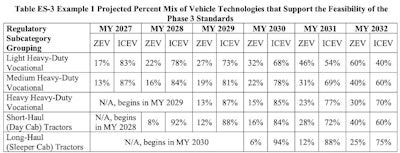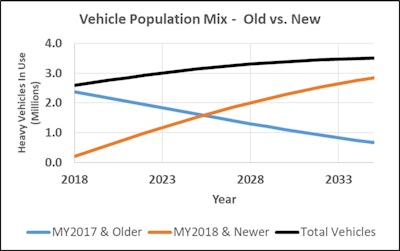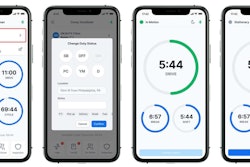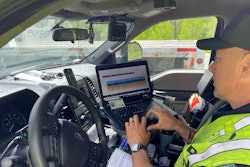Several reputable trucking industry groups have issued reports, testified in Congress, and/or occupied social media headlines about how the latest Phase 3 EPA greenhouse gas (GHG) rules are mandating battery electric trucks for long haul. The overall impression being conveyed is that all long-haul trucks are going to be battery electric.
Let’s dig into that misperception. Cummins summarized the GHG rules in a recent news release titled Key Takeaways from Stringent Standards Set by EPA’s New Emission Rule. Pay particular attention to the bottom row of the table conveniently labeled “Long-Haul (Sleeper Cab) Tractors.”

Note that in 2030, 94% of new trucks sold are likely to be internal combustion engine (ICE) vehicles. In 2032, the expectation is that 75% of new vehicle sales will be ICE models. In a good truck sales market year, all the OEMs combined produce perhaps 300,000 new trucks. That indicates that in 2032, 225,000 of those new trucks are likely to be ICE and only 75,000 are expected to be zero-emission vehicles (ZEV).
That ZEV term is quite all-encompassing. Any zero-emission technology can fit that description. That could be battery electric, it could be hydrogen fuel cell electric, hydrogen internal combustion, or any other technology that emerges that produces no emissions.
Let’s unpack that 2032 ZEV sleeper cab number. OEMs sell more than 40% of their annual builds as day cabs, and many of those haul freight. That means in a 300,000 truck year, 180,000 trucks might be sleeper cabs, not the full 300,000. So, 25% of 180,000 new annual sleeper cab builds would be ZEVs, or 45,000 long-haul sleeper trucks in 2032.
There are a growing number of manufacturers of Class 8 trucks in North America. The old guard of Daimler, PACCAR, Volvo and Traton have been joined by Lion, Hyundai, BYD, Hyzon, Nikola, XOS, Tesla and more, according to CALSTART’s Zero-Emission Technology Inventory (ZETI) tool. For simplicity, let’s just estimate 10 OEMs make sleeper units in 2032. Annual builds for each would then average 4,500 ZEV sleeper tractors.
4,500 sleeper trucks per year seems like a small number for manufacturers that regularly produce tens of thousands of units per year.
NACFE has followed a few specific truck drivers that do a remarkable job of maximizing daily mileage. In an 11-hour driving day, where conditions allow averaging 60 mph, a driver can cover 660 miles per day. This is, however, an exception, not the rule. Most drivers average much lower speeds over their shift, and many see significant detention times so that are not actually driving 11 hours per day. JB Hunt’s 2016 report 660 minutes found their drivers were average perhaps 6 to 7 hours of actual driving time each day. NACFE’s own Run on Less technology demonstrations have seen that daily mileage might frequently be in the mid-400 miles per day. Trend data from a variety of sources, including ATRI, the recent U.S. Census Bureau Vehicle Inventory & Use Survey, and geospatial tracking by companies like Geotab, have indicated that daily miles per truck have been decreasing. NACFE suggested in the report More Regional Haul that this trend is the result of fleets placing more emphasis on getting drivers home at night to aid in driver satisfaction and retention, as well as market changes from e-commerce.
Certainly, there are team drivers who are exceeding 1,000 miles per day, and there are some diligent drivers out there doing 660 miles per day, but the majority are not. The EPA’s 2032 estimates only need 25% of all of those long-haul vehicles to be ZEVs. Clearly there is room for ZEVs to pick up some of the lower mileage vehicles while ICE vehicles continue taking the longer mileage ones.
Yet the impression being given is that all vehicles will be battery electric. Wow, what a stretch of imagination. NACFE has reported that it can take 20 years or more for a new technology to fully replace an older technology, even if every new truck built has the new technology. I presented this curve in 2017 for Stifel Transportation Equipment Equity Research showing how slowly older trucks leave the market, and how slowly new ones get built and sold to replace them. Trucks have long lives.

Used trucks will be around a while. New ones will still be available as ICE vehicles in 2032. That’s reality. That’s the regulation.
Yet the fear mongering going on wants you to believe battery electric trucks are coming tomorrow to replace all the ICE vehicles. Groups have testified in Congress that BEVs just can’t do trucking, yet they are doing it daily today in urban and regional haul applications where day cabs dominate the market, where daily mileages are well below 250 miles, where trucks cube out rather than weigh out — duty cycles well within the capability of the BEVs.
What the BEV naysayers really mean is that BEVs can’t do long haul trucking. Perhaps they are right, or not. Pepsi, Tesla and Daimler have shown they can run BEVs over 600 miles a day through rapid recharging. So, some longer range, heavy freight duty cycles are within reach today. Battery technologies should reasonably be expected to improve over time as the market demands they do — like with all technologies. Who knows what will be possible in 2032?
Whatever the long-haul story, BEVs are capable today of operating in many duty cycles. They are not going to replace every truck on the road. Nor do they have to.
My advice. Stay objective. Let fact-based decision-making guide you. Understand that ZEVs are more than battery electric trucks. Understand that not all trucks are long-haul trucks. Understand the transition to a zero-emission trucking future will take time.













